Story and Photos by Paul Ross
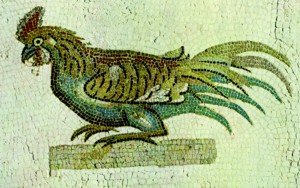
Rooster Mosaic |
Recipes:Ras el Hanout
|
From deep within the souks of North Africa comes ras el hanout, a complex, elusive and thoroughly magical blend of spices that, like the region’s celebrated mosaics, adds up to much more than the mere sum of its parts. It is common throughout Morocco, Algeria and Tunisia, where it is slightly milder than the pungent Moroccan forms.

Camel and Tent in the Desert
Exploring the ancient city of Tunis, Tunisia’s capital, I discovered ras el hanout with the help of a guide, Karim, who lived in a fourteenth century building near the medina, the heart of the old city. The befuddling maze of ancient streets–so capable of captivating tourists in both senses of the word–is his well-worn path to friendship, adventure and commerce. In pursuit of just the right thing, Karim lead me past a dozen spiceries to the one where he and his family shopped. The tiny place was literally packed to the rafters with large tins of fiery harissa; shelves competed with shelves to display brilliant colored powders and exotic herbs, and barrels of eight varieties of olives spilled out in the narrow alleyway. The colors and aromas were almost too much. I wanted to eat the air in there.

Mosaic of Fishermen
The shop owner, Nouridine, proffered a scoop of finely-ground, dried ginger under my nose. At his repeated insistence, I inhaled the sunny, woody aroma; I could taste it dancing around the back of my mouth. “Imported,” he said, then snatched up a second scoop and held it out for my olfactory delectation, saying proudly, “This is Tunisian.” Doubting that I’d sense a difference but obliging, I sniffed. It was different: rich, dense, smoky and sensual with a fiery fillip at the end.

Desert Musicians
It was amazing that so small a space held such a trove of gustatory treasure. Customers darted up, paid a few dinar for a spice or an herb and trotted off with their purchase smartly-wrapped in pieces of recycled newspaper. In between sales, we got down to discussing ras. According to Nouridine, ras el hanout is rarely made at home. Most is bought in the market, from spice sellers who specialize in blending. The ingredients can include coriander, chiles, cumin, cardamom, turmeric, mace, galangal, anise, cinnamon, nutmeg, peppercorns, cloves, peppermint, rosemary, thyme, oregano, ginger, lavender and rosebuds.
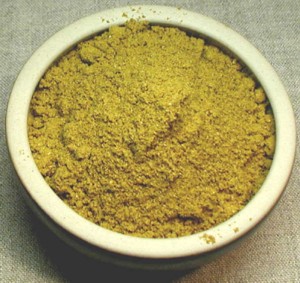
Ras el Hanout
The ground powder is recommended for everything but fish, which it tends to overpower or fight. But I tried a pinch with white wine and olive oil to saute calamari and the result was wonderful.
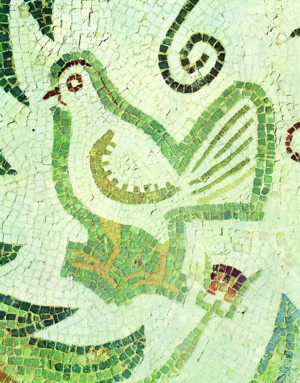
Bird Mosaic
Most of us foodies back here in the U.S. have to formulate our own ras el hanout, but then again, we’d probably want to anyway and–for chileheads and the like–it’d be the way to turn up the heat. The versatile ras can take it. In fact, I found an easy mixture of chile-plussed ras added to olive oil and vinegar made for a great salad dressing or marinade. (On the other hand, dry rubbing doesn’t work as the subtler spices grill away over direct flame.)
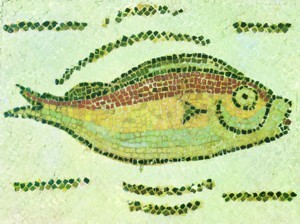
Fish Mosaic
In major U.S. cities with ethnic populations, specialty markets are now starting to stock some packaged varieties of ras el hanout, however the freshness of such items should–whenever possible–be tested. Or, book a flight, savor the souks, and shop.
Ras el Hanout
A typical North African spice merchant can carry up to 200 different spices and herbs, so it’s no wonder that there is a mind-boggling number of these blends. Many blends contain dried flowers, and some are said to contain the dried green beetles called Spanish Fly. Here we’ve included flowers but no Fly.
1 teaspoon caraway seeds
1 teaspoon cumin seeds
1 teaspoon coriander seeds
1/4 teaspoon cardamom seeds
1 (2-inch piece) cinnamon stick
6 allspice berries
4 whole cloves
1/4 teaspoon dried lavender, optional
1 1/2 teaspoons freshly ground black pepper
1 teaspoon ground ginger
1/2 teaspoon ground cayenne chile
1/4 teaspoon freshly grated nutmeg
1/4 teaspoon ground turmeric
Heat a heavy skillet over high heat. Add the caraway, cumin, coriander, cardamom, cinnamon, allspice, and cloves and dry roast until the seeds darken and become fragrant, being careful that they don’t burn. Allow the mixture to cool completely.
Place the toasted mixture in a spice mill or coffee grinder along with the lavender, and process to a fine powder. Sift the mixture if you want a fine blend.
Combine the toasted mix with the ground spices and stir to blend. Store in an airtight container.
Yield: 2 to 3 tablespoons
Heat Scale: Medium
Tunisian Carrot Salad
This salad travels well and can be made a day ahead. If you refrigerate it overnight, bring it to room temperature before serving.
1 1/2 pounds carrots, peeled, cut into 1/4-inch-thick rounds
3 tablespoons olive oil
2 1/4 teaspoons ground cumin
1/4 teaspoon cayenne pepper
1/2 cup water
3 tablespoons white wine vinegar
Salt and freshly ground black pepper, to taste
1/3 cup chopped cilantro leaves
Cook the carrots in salted boiling water until they are crisp tender, about 8 minutes. Drain well.
Add the olive oil to a large skillet over medium heat. Add the cumin and cayenne and heat until aromatic, about 1 minute. Add the carrots, 1/2 cup water and vinegar. Simmer over medium heat until the liquid is absorbed, stirring often, about 5 minutes. Remove from heat. Cool. Mix in cilantro and season with salt and pepper.
Yield: 4 Servings
Heat Scale: Mild
Mechouia
For this traditional appetizer the vegetables can be served chopped or very briefly processed in a food processor or blender to make a chunky dip. Either way, serve it with warm, fresh pita bread.
2 large onions, sliced into thick rounds
2 red bell peppers
4 medium tomatoes
1 small hot pepper, such as serrano
1 (7-ounce) can tuna, packed in water
2 ounces crumbled feta cheese
2 hard boiled eggs, chopped
Salt and freshly ground black pepper, to taste
3 tablespoons fresh lemon juice
3 tablespoons olive oil
1 teaspoon fresh oregano
Over the flame of your gas range, under a broiler, or on a grill, cook the onions until the edges char slightly and the onions soften. Transfer the onions to a plate to cool.
Over the flame, char the bell peppers, tomatoes and hot pepper until dark and blistered. Place them in a bowl and cover with a dish towel for 10 minutes. When cool enough to handle, remove the stems, seeds, and charred skin, then dice. Dice the onion.
Place the vegetables on a flat serving platter and top with the tuna, feta and hard-boiled eggs. Sprinkle with salt and pepper.
In a small bowl, stir together the lemon juice, olive oil and oregano and pour it over the platter.
Yield: 4 Servings
Heat Scale: Medium
Harissa
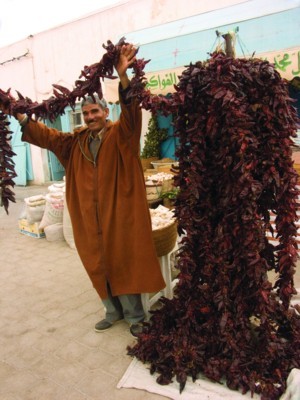
Tatouine Chile
Harissa is from the Arabic word for “to break into pieces,” which refers to the traditional method of preparation that involves pounding peppers into a coarse paste. Modern methods using a blender or food processor produce a harissa that is more of a sauce. There are many variations of this condiment. Although it’s available commercially, it’s easy to prepare and will keep for many weeks in the refrigerator, why not prepare it fresh? It’s commonly used as a condiment with couscous, vegetable and meat tagines, grilled foods, and to flavor soups and egg dishes.
7 dried red New Mexican chiles, stems and seeds removed, or substitute 5 small hot chiles like piquin
1 tablespoon ground paprika
2 tablespoons olive oil
5 cloves garlic
1 teaspoon cumin seeds (or 1/2 teaspoon ground cumin)
1 teaspoon ground coriander
1/2 teaspoon caraway seeds
2 tablespoons fresh lemon juice
1 tablespoon chopped fresh mint, optional
1 teaspoon salt
1 teaspoon freshly ground black pepper
Place the chiles in a bowl, cover with very hot water and steep 15-20 minutes. Drain the chiles and discard the water.
Place all the ingredients, except the oil, in a blender or food processor and puree until smooth. With the motor running, add the oil in a steady stream to form a thick sauce.
Yield: 1/3 to 1/2 cup
Heat Scale: Hot
Merguez (Lamb Sausages)
These spicy sausages are usually grilled and eaten alongside couscous.
3 pounds lean lamb, trimmed
1 tablespoon salt
1 1/2 tablespoons cumin
2 teaspoons coarse ground black pepper
1/4 cup paprika
1 1/2 teaspoon cayenne pepper
1 teaspoon cinnamon
1/2 cup pomegranate juice
1 1/2 tablespoons minced garlic
1 teaspoon dry ginger
1 teaspoon thyme leaves
Natural or vegetable casings
Grind the lamb once through the medium (1/8-inch) plate of a meat grinder.
In a large bowl, mix together all remaining ingredients and add the meat, using your fingers to combine.
Attach the stuffing horn to your grinder and prepare the casings. Grind the mixture through the 1/8-inch plate again, through the stuffing horn and into the casings. Twist and tie the sausages into 5-inch lengths.
Yield: 12 to 15 sausages
Heat Scale: Mild
Le Bifteck a la Carthage
Serve this steak with couscous.

Photo: Norman Johnson
1 (2-pound) flank steak
1 cup onion, finely chopped
1 tablespoon chopped garlic
1/2 cup olive oil
1/2 cup lemon juice
2 tablespoons soy sauce
1 tablespoon dry sherry
1/4 cup fresh oregano
2 teaspoons hot sauce
1 teaspoon turmeric
1 teaspoon dried marjoram
Salt and freshly ground black pepper, to taste
Combine all of the ingredients in a large zippered plastic storage bag. Marinate in the refrigerator 1 to 2 hours.
Prepare your gas or charcoal grill.
Remove the steak from the bag and pat it dry. Grill to medium rare. Allow the cooked meat to rest 10 minutes before slicing thinly, at a 45-degree angle.
Yield: 4 servings
Heat Scale: Mild




